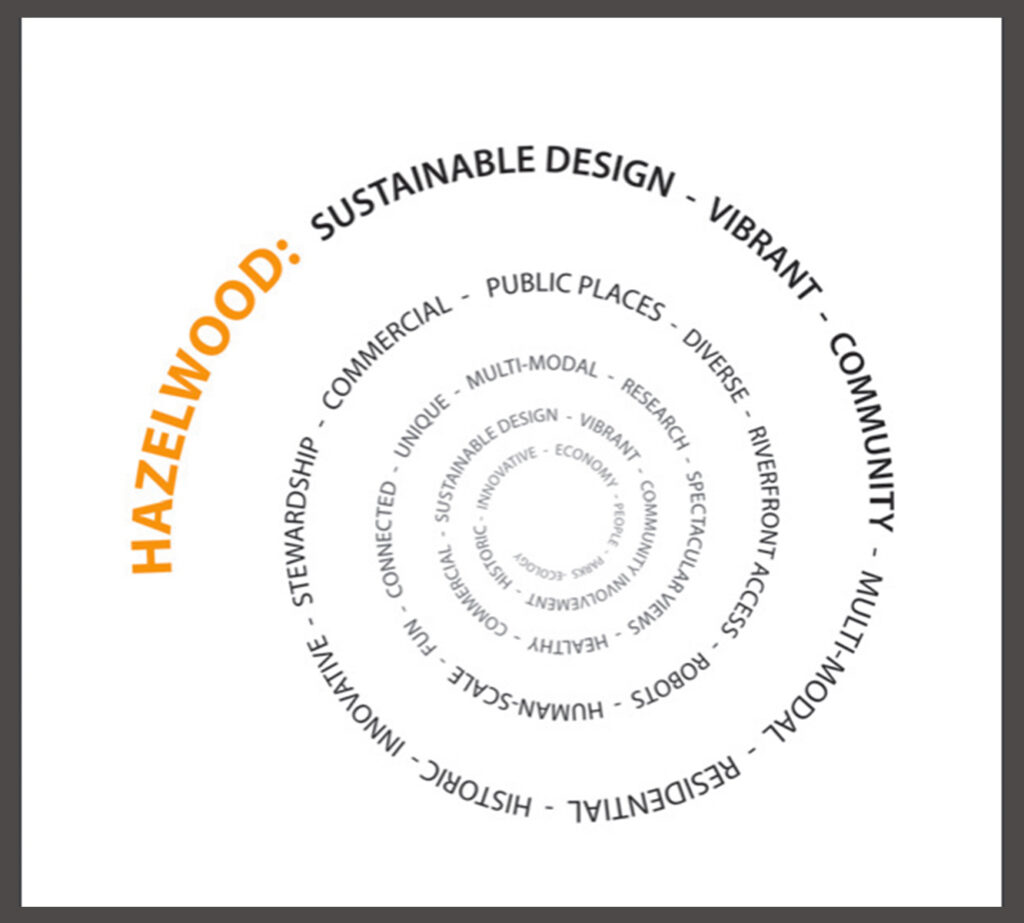
By Junction Coalition
In 2009, as Barack Obama settled into his first term as president and future Pittsburgh mayor Bill Peduto campaigned for another term on City Council, the Remaking Cities Institute of Carnegie Mellon University (CMU) released a document of “recommendations” called Remaking Hazelwood.
This document is more relevant than ever as Mayor Peduto prepares to step down. His tenure is defined by catering to local universities and foundations—as well as bending over backward for companies like Amazon and Uber.
That Peduto failed to transform CMU’s recommendations into reality was not for lack of trying. Many items from CMU’s 2009 wish list resurfaced during Peduto’s two terms as his own lofty visions for Pittsburgh’s future. One such item was a bridge across the Monongahela River to service Almono Partners’ development site (Hazelwood Green). Other elements of the plan required adjustments over the years, such as placement of the controversial Mon-Oakland Connector (MOC) shuttle road.
Close examination shows the report went a long way toward setting the Peduto administration’s agenda. Page numbers are referenced as marked in the document itself.
What stayed the same:
Disregard for residents of Four Mile Run (The Run)
The Run is expressly listed among the communities in the “focus area” of recommendations and referenced as “The Run section of Hazelwood” (p. 6, 20, 28). However, The Run is officially part of Greenfield and Run residents were not consulted about the Remaking Cities Institute’s plan.
This inaccuracy reveals the hypocrisy of statements like the one on p. 40: “The community vision is for the full integration of Hazelwood, Oakland and Junction Hollow into the mixed-used (sic) redevelopment of the ALMONO site. The community has stated repeatedly that it wishes to see a diversity of uses that would expand existing training and employment opportunities for residents and create stronger physical and economic connections to surrounding communities.”
When the report states, “Local residents and business owners have participated in several community visioning and planning processes (p. 44),” it is referring to Hazelwood residents and business owners. Run residents learned of the city’s intent to build the MOC through their neighborhood from a 2015 Pittsburgh Post-Gazette article.
No “community visioning” process took place in The Run even though “[i]nterventions included a dense, mixed-use waterfront district at the foot of Junction Hollow [directly adjacent to The Run]…” (p. 18). Also referenced as a “Transit Oriented Development” called “Four Mile Run Neighborhood,” its “high-rise apartments atop a multi-modal station at the base of Junction Hollow near Greenfield Avenue and the Pittsburgh Technology Center” would wall off the original Four Mile Run neighborhood from the river and downtown skyline (p. 76, 85).
In 2018, Hazelwood Green’s developers requested and received a zoning change that allowed this exact site to accommodate buildings up to 24 stories high instead of the 15 stories allowed by the Greater Hazelwood Neighborhood Plan.
Besides working with certain Hazelwood organizations, in 2009 Almono Partners was collaborating with the Pittsburgh Parks Conservancy (PPC) on improvements to Schenley Park. The improvements were not designed to fix combined sewer overflows in the area, although the report came out the same year as a devastating 75-year flood in The Run. Some proposed “improvements” even had the potential to worsen matters, such as replacing grass with artificial turf and adding acres of other impervious surfaces.
A section on p. 45 discusses daylighting “the buried Four Mile Run [stream]” and concludes, “Addressing the hydrological system will not only help ecological functions and create aesthetic and recreational landscapes but also return what has become a serious and costly liability, as well as image problem, into an asset by alleviating combined sewage and stormwater overflow contamination.” There is no mention of protecting Run residents’ lives and property.
Ensuing years have brought more floods to The Run—10 major ones in the past 15 years—along with increased public awareness. Almono Partners and the authors of Remaking Hazelwood knew the nature of the problem in 2009, if not before. But they focused on building the MOC, not addressing the flooding.
Lip service to Hazelwood’s needs while promoting conditions that displace existing community members
On p. 24, the report acknowledges that during the post-industrial/economic decline after 1960, “Hazelwood’s existing conditions are the result of cumulative years of disinvestment that has affected every sector.”
However, lest one think investment means a reversal of intentions behind the earlier disinvestment, the report again conflates Hazelwood with The Run. “Hazelwood’s landscape has been altered in the past two centuries at a rate that far exceeds previous natural morphological transformation… The most notable change has been the burial of the Four Mile Run [stream].”
After acknowledging the risk of displacing poor and black residents, the report presents a chart on p. 31 that predicts Hazelwood will experience the most dramatic population growth in Pittsburgh because of development on Hazelwood Green. If the report does not celebrate the prospect of displacement, it also does not offer any specific, well-formulated ideas for preventing this outcome.
Page 41 features unfortunate word art depicting “Hazelwood” at the event horizon of buzzwords swirling in a formation that evokes the community circling the drain as a result of being sold off to private interests.

A “permanent, speedy connection” between Oakland and Hazelwood for university personnel
The report is not coy about this key wish-list item: “The importance of providing a permanent, rapid link between Hazelwood, Oakland and downtown cannot be overstated. It is the singular most important gesture that will ensure the success of the ALMONO site’s redevelopment.” (p. 45, emphasis in original)
One reason for the link between Oakland and the development site: “In addition to the private market, Carnegie Mellon is interested in developing new housing for 500 undergraduate and 500 graduate students … If transportation can be provided to the main campus, the ALMONO site could prove a viable site for university-affiliated housing.” (p. 36) This plan seems to prioritize packing students into profitable housing—essentially expanding CMU’s campus—above the needs of existing residents.
Control of publicly-held land in Junction Hollow
Creating a dedicated “link” between the development and universities rather than using existing routes also reflects a long-term goal to privatize the Junction Hollow corridor: “Carnegie Mellon University and local partners Oakland Catholic High School, Central Catholic High School, and Winchester Thurston School have proposed building three artificial surfaced athletic fields in Junction Hollow which, outside of their programming, would be open to the public.” (p. 32)
The report does not mention the existing fully public soccer field in Junction Hollow—part of Schenley Park, a public park. Additional references to CMU and partners taking over Junction Hollow with “semi-public” athletic fields are on p. 66, 77, 88, and 89.
Re-imagining all nearby infrastructure to support the ALMONO development
In March 2019, the Pittsburgh Post-Gazette’s editorial board rhapsodized over Mayor Peduto’s “great idea” to build a new bridge between Becks Run Road and Hazelwood Green. But the idea wasn’t new—it can be found on p. 45, 61, and 73 of the 2009 Remaking Hazelwood report.

The report’s authors express their view of Pittsburgh as their playground on p. 45: “The urban design recommendations proposed in this document extend beyond the boundary of the ALMONO site. The end of Four Mile Run valley, the hillside and Second Avenue are all critical to the overall framework. Some of these areas are publicly-held; others are privately-owned. A map is in the section Development Constraints. The support of the City of Pittsburgh and the Urban Redevelopment Authority (URA) will be critical to the success of our vision. The ALMONO, LP could try to purchase these sites. Failing that, the URA can support the project by purchasing those properties that are within the scope of the recommendations and making them available for redevelopment in accordance with the proposed strategy.”
To a lesser degree, they also suggest an inverse strategy: disinvestment in infrastructure that is not useful to Hazelwood Green. For example, on p. 78: “In twenty years or so, we propose that the portion of Second Avenue between Greenfield Avenue and Mobile Street (currently named Irvine Street) be closed and the space incorporated into the Hazelwood Greenway, perhaps to be used for productive landscapes, sustainable water capturing landscapes or recreational fields.” A long-range vision on p. 138 includes more details about “Four Mile Run Neighborhood” and possible closure of Irvine St. between Greenfield Ave. and Minton St.
What changed:
Environmental friendliness cooled
The report’s call for expanding the Hazelwood Greenway has given way to visions of slicing and shrinking the forested corridor. In Sept. 2021, the URA began talks with Oak Moss Associates, a developer that wants to level a young forest in Hazelwood to accommodate the 62 rental units (reduced from the original 66) it calls Woods Village.
On p. 44 the report names “proximity to a major urban park” (Schenley) as an asset that should be preserved—but expedience has tempered this sentiment over the years as well. Building a new road through the park, proposed as part of the MOC, threatens to destroy the park. Green infrastructure for stormwater management in the park has been abandoned in favor of gray infrastructure.
CSX nixed use of their rail lines
The report imagined “[t]he LRT line would use existing CSX rail lines. A stop in Junction Hollow would be contingent on the renovation of Panther Hollow Lake by the PPC, the construction of a new pedestrian and bike overpass between Schenley Park and South Oakland, and the addition of the proposed semi-public sports fields by Carnegie Mellon University and its educational partners.” (p. 88)
From the report’s Land Assembly section on p. 46: “There are two zones of privately-held and publicy-held (sic) that are critical to the overal (sic) vision of the ALMONO site redevelopment: The area between Junction Hollow and the ALMONO site includes land that is critical to the implementation of the LRT line and Transit Oriented Development proposal. The completion of the Riverside neighborhood at the southern end of the ALMONO parcel requires the acquisition of part of the lands currently used for the Glenwood Rail Yard.”
By all accounts, the railroad company did not take kindly to discussions of acquiring their land. In response to MOC opponents’ criticism of its disruptive route through the middle of a public park, city officials often refer to these original plans and lament that CSX is “hard to work with.”
Will to fund Junction Hollow-Panther Hollow Lake connection disappeared
The report enthused on p. 32, “The PPC is currently studying the possibility of daylighting a portion of Four Mile Run in order to reduce the stormwater burden on the Monongahela River and is considering building a pedestrian bridge between Panther Hollow Lake and South Oakland.” Park users and city officials unanimously agree: A legal connection between Panther Hollow Lake and “South Oakland” (i.e., Panther Hollow) is crucial. Yet this much-needed way to safely cross the railroad tracks has no funding, and officials have no plan to secure it.
“Robot City” went underground
CMU is known for its military-funded research and development of robots, but typically refrains from publicizing that part of its work. However, the Remaking Hazelwood authors gushed about making Robot City a centerpiece of the ALMONO/Hazelwood Green development: “Robot enthusiasts and passersby could view non-military testing occurring on the site through viewing platforms.” (p. 102)
Robot City, too, relied on building the MOC: “A permanent, speedy connection to Carnegie Mellon and Oakland via Junction Hollow is considered a requirement for Robot City’s success, permitting an unobstructed flow of researchers, students and faculty.” (p. 100)
The idea of hosting killer robots lacks community appeal, and Robot City has retreated to obscurity in public discussions of Hazelwood Green.
Who decides the future?
Strong community opposition has plagued the MOC plan since it emerged from its silo of professional consultants and friendly focus groups. Six years after its original public unveiling, construction has yet to begin. During the 2021 mayoral primary election campaign, only Mayor Peduto endorsed the MOC—and became Pittsburgh’s first incumbent mayor to be unseated since 1933. Public officials confide off the record that the MOC is “dead.” But dreams backed by enough money and power never die. The MOC and the Hazelwood Green bridge both feature in Pittsburgh’s 2070 Mobility Vision Plan.
Mayor Peduto sells the visions of Pittsburgh’s foundations, universities, and big developers as essential to Pittsburgh’s future, yet developing those visions behind closed doors leaves a huge blind spot when it comes to the future of Pittsburgh’s residents. More and more people are being pushed to the city outskirts and beyond thanks to unchecked real estate speculation. Mayor Peduto’s administration has sacrificed his constituents to fulfill the dreams of moneyed interests.
Time has shown that CMU is unwilling to reconsider its priorities—even where they contradict the feel-good language in their Remaking Hazelwood report and undermine their supposedly community-empowering/environmentally friendly goals.
A statement on p. 44 of the report offers insight on why they feel no need to do so: “As philanthropic foundations, the ALMONO, LP partners operate within a different accountability paradigm than municipal governments, for-profit and non-profit developers.”

